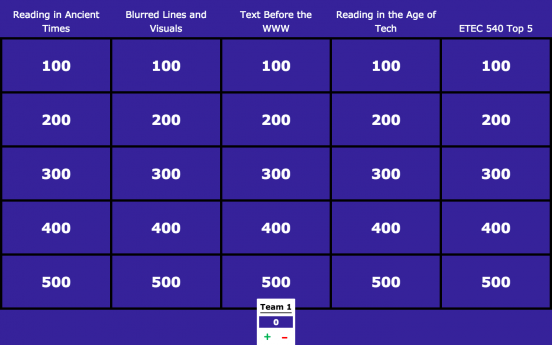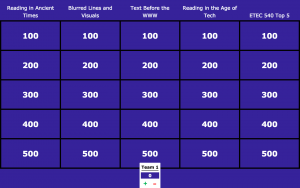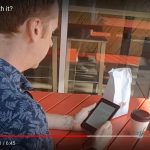https://jeopardylabs.com/play/reading-jeopardy-375
The link above will take you to my multimedia project. I opted to create a Jeopardy-type game based on the content and ideas I gleaned from the course. In it, you will find direct quotes from our textbooks and ideas from some of our readings. The content is based on the entire course, but it does give an heavier focus on my topic of “reading” and as such might be a chip off my other two project, but there is enough general content that you could easily ace the game, assuming you have enjoyed the readings as much as I did 😉
The compilation of the project was a winding road. I viewed many of the submissions from previous cohorts on YouTube and wanted to have something original, interactive, and fun. This took my thoughts back to a course I took last semester that examined ‘gamification’ and I wondered how I could work that aspect into this project. A game show would be ideal, but how could I do that with you asynchronously? My mind kept going back to the mass amount of information we were presented with in our readings and I kept going back to Jeopardy. Hence the final project you see here.
Initially, I was going to use my good friend PowerPoint to create the game. I have used PowerPoint in the past to create games for my students, but they were not distributed on the web and were largely facilitated by the educator. This format had too many issues to be viable on a web-based platform and to be used independently in any meaningful way. I needed something that would tally your points (albeit this version lets you decide if you got the correct answer) as well as take category questions out of action once they were answered. I stumbled across this platform, written, written in HTML, CSS, and JavaScript and it seemed almost ideal. It was written by a student at Washington State University in Vancouver. Apparently, there used to be an advanced version into which I could put images and video clips for a one-time fee of $20, but the payment screen was disabled, so you are treated only to the text version.
As a stand-alone project, I could not add references directly to my project, although there are inline citations to support many of the “answers”. Below you will find the full APA refernce list.
At this point, I would like to thank you for all your blog postings, many of which lead me to further examine the readings and gain a deeper understanding of the course material and the threads it took you on. One of the things I enjoyed about this course was the wide variety of projects we created and how they ultimately could relate to each other.
I hope you enjoy this little project. If you have a moment, post your score below and we can crown our own Jeopardy champion.
References:
Bolter, J. D. (2001). Writing Space: Computers, Hypertext, and the Remediation of Print. Mahwah: Lawrence Erlbaum Associates, Inc.
Engell, J. (Presenter) & O’Donnell, J. (Presenter). (1999). From Papyrus to Cyberspace [radio broadcast]. Retrieved from https://canvas.ubc.ca/courses/4290/files/609973/preview
Kress, Gunter. (2005). “Gains and losses: New forms of texts, knowledge and learning. Computers and Composition. 22(1), 5-22.
Ong, W. (2002). Orality and Literacy. London: Routledge.
Peña, E. (n.d.). Thinking About Text and Technology. Reading. Retrieved August 1, 2018, from https://canvas.ubc.ca/courses/8770/pages/thinking-about-text-and-technology?module_item_id=446323
Scott, C. (2018, July 22). Rip.Mix.Feed – Reading [Web log post]. Retrieved from https://blogs.ubc.ca/etec540summer2018/2018/07/22/rip-mix-feed-reading/





marcia kondo
August 2, 2018 — 3:41 pm
Hi Carri-Ann!
You did a great job with your project! This Jeopardy game is creative and fun and really showcases ideas from the entire course. I’m sorry I didn’t complete the whole game so I don’t have a score to share yet but I played around with it and love what you put together for this assignment.
And yes, that is my daughter in my project. 🙂
Marcia